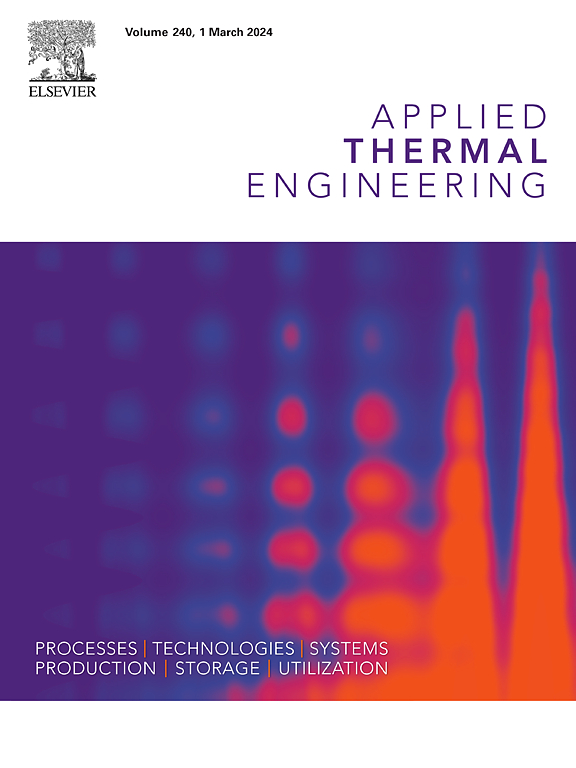Experimental study on fire suppression of NCM lithium-ion battery by C6F12O in a confined space
IF 6.1
2区 工程技术
Q2 ENERGY & FUELS
引用次数: 0
Abstract
To investigate the suppression effect of C6F12O on the thermal runaway (TR) of NCM soft-pack lithium-ion battery (LIB) in a confined space, a combustion and suppression experimental platform was established. A 300 W heating panel was employed as an external heat source to induce TR. Results indicate that, in the absence of agents, the TR process of the fully charged NCM soft-pack battery exhibited pronounced gas release and intense jet flames, with the entire event lasting approximately 20 s. The average peak temperature on the back side of the cell (Tb-max) could be reached up to 776.5 ℃, corresponding to an average peak temperature 539.8 ℃ in surrounding environment, highlighting the potential for severe thermal hazards. The critical extinguishing dose (Xext) and the critical thermal suppression dose (Xsup) of C6F12O were determined based on its extinguishing and cooling effects. The application of C6F12O could lead to the extinguishment of battery flames within 3 s, with the Xext not less than 2.62 kg/kWh. However, low dose (0.07 kg and 0.15 kg) of C6F12O can exacerbate the temperature rise of LIBs after TR, potentially leading to re-ignition. Whereas a dosage exceeding of Xsup = 5.48 kg/kWh can exert a positive suppression effect to counteract this influence. This research provides valuable insights for selecting the optimal C6F12O dosage and designing effective firefighting measures against LIB fires, while also offering novel research directions for extinguishing strategies.
密闭空间中 C6F12O 对 NCM 锂离子电池灭火的实验研究
为了研究 C6F12O 对密闭空间中 NCM 软包锂离子电池(LIB)热失控(TR)的抑制作用,我们建立了一个燃烧与抑制实验平台。实验采用 300 W 的加热板作为外部热源来诱导 TR。结果表明,在没有药剂的情况下,充满电的 NCM 软包电池在 TR 过程中表现出明显的气体释放和强烈的喷射火焰,整个过程持续约 20 秒。电池背面的平均峰值温度(Tb-max)可高达 776.5 ℃,与周围环境的平均峰值温度 539.8 ℃ 相对应,凸显了潜在的严重热危害。根据 C6F12O 的熄灭和冷却效果,确定了其临界熄灭剂量(Xext)和临界热抑制剂量(Xsup)。在 Xext 不小于 2.62 kg/kWh 的情况下,施用 C6F12O 可在 3 秒内熄灭电池火焰。然而,低剂量(0.07 千克和 0.15 千克)的 C6F12O 会加剧 TR 后锂电池的温度上升,从而可能导致复燃。而超过 Xsup = 5.48 kg/kWh 的剂量则可以发挥积极的抑制作用,抵消这种影响。这项研究为选择最佳的 C6F12O 用量和设计有效的锂电池火灾灭火措施提供了宝贵的见解,同时也为灭火策略提供了新的研究方向。
本文章由计算机程序翻译,如有差异,请以英文原文为准。
求助全文
约1分钟内获得全文
求助全文
来源期刊

Applied Thermal Engineering
工程技术-工程:机械
CiteScore
11.30
自引率
15.60%
发文量
1474
审稿时长
57 days
期刊介绍:
Applied Thermal Engineering disseminates novel research related to the design, development and demonstration of components, devices, equipment, technologies and systems involving thermal processes for the production, storage, utilization and conservation of energy, with a focus on engineering application.
The journal publishes high-quality and high-impact Original Research Articles, Review Articles, Short Communications and Letters to the Editor on cutting-edge innovations in research, and recent advances or issues of interest to the thermal engineering community.
 求助内容:
求助内容: 应助结果提醒方式:
应助结果提醒方式:


